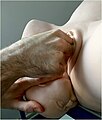
The human leg, in the general word sense, is the entire lower limb of the human body, including the foot, thigh and even the hip or gluteal region. However, the definition in human anatomy refers only to the section of the lower limb extending from the knee to the ankle, also known as the crus or, especially in non-technical use, the shank. Legs are used for standing, and all forms of locomotion including recreational such as dancing, and constitute a significant portion of a person's mass. Female legs generally have greater hip anteversion and tibiofemoral angles, but shorter femur and tibial lengths than those in males.

The brachial plexus is a network of nerves formed by the anterior rami of the lower four cervical nerves and first thoracic nerve. This plexus extends from the spinal cord, through the cervicoaxillary canal in the neck, over the first rib, and into the armpit. It supplies afferent and efferent nerve fibers to the chest, shoulder, arm, forearm, and hand.

The pubic symphysis is a secondary cartilaginous joint between the left and right superior rami of the pubis of the hip bones. It is in front of and below the urinary bladder. In males, the suspensory ligament of the penis attaches to the pubic symphysis. In females, the pubic symphysis is close to the clitoris. In most adults it can be moved roughly 2 mm and with 1 degree rotation. This increases for women at the time of childbirth.
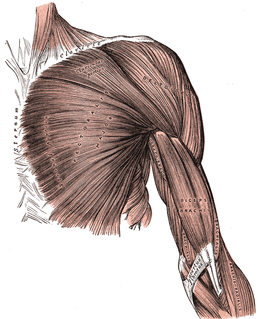
The pectoralis major is a thick, fan-shaped or triangular convergent muscle, situated at the chest of the human body. It makes up the bulk of the chest muscles and lies under the breast. Beneath the pectoralis major is the pectoralis minor, a thin, triangular muscle. The pectoralis major's primary functions are flexion, adduction, and internal rotation of the humerus. The pectoral major may colloquially be referred to as "pecs", "pectoral muscle" or "chest muscle" due to it being the largest and most superficial muscle in the chest area.

The teres minor is a narrow, elongated muscle of the rotator cuff. The muscle originates from the lateral border and adjacent posterior surface of the corresponding right or left scapula and inserts at both the greater tubercle of the humerus and the posterior surface of the joint capsule.

Shoulder dystocia is when, after vaginal delivery of the head, the baby's anterior shoulder gets caught above the mother's pubic bone. Signs include retraction of the baby's head back into the vagina, known as "turtle sign". Complications for the baby may include brachial plexus injury, or clavicle fracture. Complications for the mother may include vaginal or perineal tears, postpartum bleeding, or uterine rupture.

The abdominal external oblique muscle is the largest and outermost of the three flat abdominal muscles of the lateral anterior abdomen.
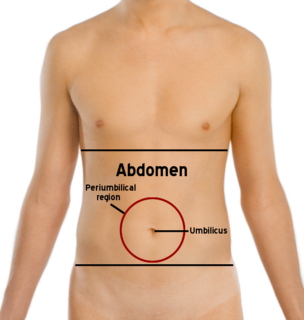
The abdomen is the part of the body between the thorax (chest) and pelvis, in humans and in other vertebrates. The abdomen is the front part of the abdominal segment of the torso. The area occupied by the abdomen is called the abdominal cavity. In arthropods it is the posterior tagma of the body; it follows the thorax or cephalothorax.

In vertebrates, the pubic bone is the most forward-facing of the three main bones making up the pelvis. The left and right pubic bones are each made up of three sections, a superior ramus, inferior ramus, and a body.
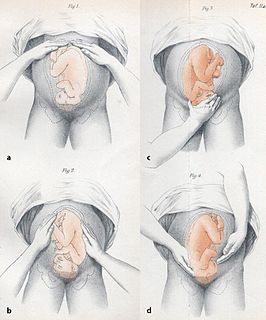
In obstetrics, Leopold maneuvers are a common and systematic way to determine the position of a fetus inside the woman's uterus; they are named after the gynecologist Christian Gerhard Leopold. They are also used to estimate term fetal weight.
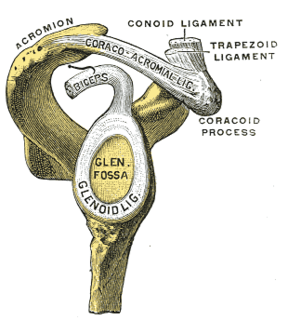
A SLAP tear or SLAP lesion is an injury to the glenoid labrum. SLAP is an acronym for "superior labral tear from anterior to posterior".

The McRoberts maneuver is an obstetrical maneuver used to assist in childbirth. It is named after William A. McRoberts, Jr. It is employed in case of shoulder dystocia during childbirth and involves hyperflexing the mother's legs tightly to her abdomen. It is effective due to the increased mobility at the sacroiliac joint during pregnancy, allowing rotation of the pelvis and facilitating the release of the fetal shoulder. If this maneuver does not succeed, an assistant applies pressure on the lower abdomen. Current guidelines strongly recommend against pulling on the infants head, as this could lead to brachial plexus injury. Instead, support while keeping the neck straight is indicated. The technique is effective in about 42% of cases. Note that suprapubic pressure and McRobert's maneuver together will resolve 90% of cases.
Wood's screw maneuver is practiced in obstetrics when dealing with shoulder dystocia – a condition in which the fetal shoulders cannot easily pass through the vagina. In this maneuver the anterior shoulder is pushed towards the baby's chest, and the posterior shoulder is pushed towards the baby's back, making the baby's head somewhat face the mother's rectum.
Anterior shoulder in obstetrics refers to that shoulder of the fetus that faces the pubic symphysis of the mother during delivery. Depending upon the original position of the fetus, either the left or the right shoulder can be the anterior shoulder. It is known as the anterior shoulder as it faces the anterior of the mother. This distinction between the anterior and the posterior shoulder is important as the anterior shoulder is delivered first.

In obstetrics, the presentation of a fetus about to be born specifies which anatomical part of the fetus is leading, that is, is closest to the pelvic inlet of the birth canal. According to the leading part, this is identified as a cephalic, breech, or shoulder presentation. A malpresentation is any presentation other than a vertex presentation.

A shoulder presentation refers to a malpresentation at childbirth where the baby is in a transverse lie, thus the leading part is an arm, a shoulder, or the trunk. While a baby can be delivered vaginally when either the head or the feet/buttocks are the leading part, it usually cannot be expected to be delivered successfully with a shoulder presentation unless a cesarean section (C/S) is performed.

The hip bone is a large flat bone, constricted in the center and expanded above and below. In some vertebrates it is composed of three parts: the ilium, ischium, and the pubis.
Mauriceau–Smellie–Veit maneuver or Mauriceau maneuver is an obstetric or emergent medical maneuver utilized in cases of breech delivery. This procedure entails suprapubic pressure by one obstetrician on the mother/uterus, while another obstetrician inserts left hand in vagina, palpating the fetal maxilla using the index and middle finger and gently pressing on the maxilla, bringing the neck to a moderate flexion. The left hand's palm should rest against the fetus' chest, while the right hand can grab either shoulder of the fetus and pull in the direction of the fetus' pelvis. The combined neck flexion, traction on the fetus toward the hip/pelvis, and the suprapubic pressure on the mother/uterus allows for delivery of the head of a breech infant, granted prior breech delivery steps are followed and the infant's occipitus is rotated/facing anteriorly relative to the mother.

The pelvis is the lower part of the trunk, between the abdomen and the thighs, together with its embedded skeleton.

Emergency childbirth is the birth of an infant in places or situations other than what was planned. In most cases the location of childbirth is planned ahead of time and may be at home, a hospital, a medical facility or a birthing center. In other situations, the birth occurs on the way to these facilities. Oftentimes, no trained medical personnel are present, other times there may be police or other first responders. Emergency measures for delivery are indicated when childbirth is imminent.

